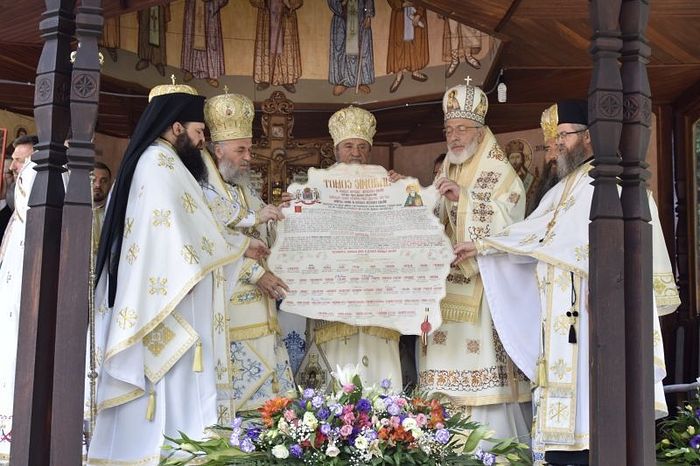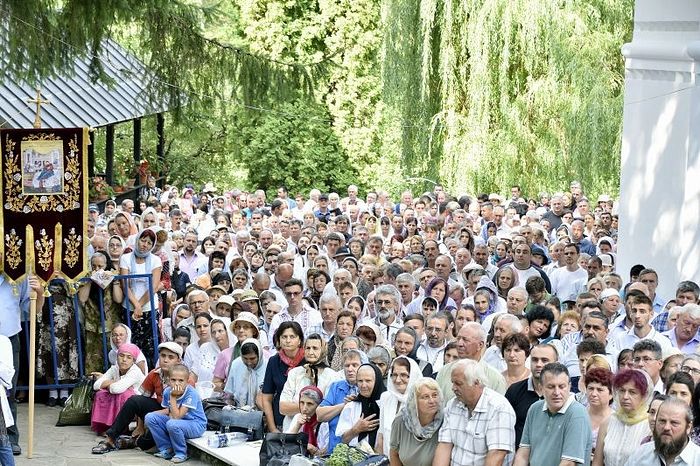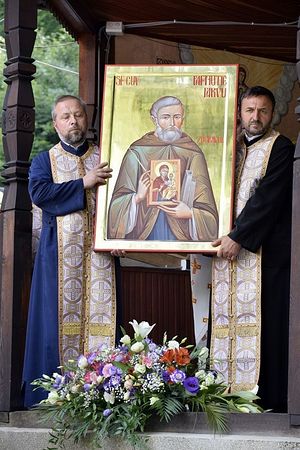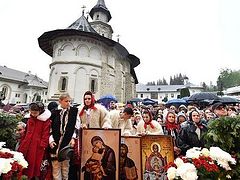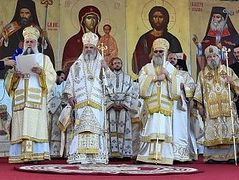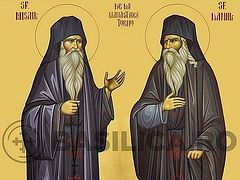Robaia, Argeș, Romania, August 7, 2017
The Romanian Orthodox Church liturgically glorified a new saint on Sunday, the feast of the Transfiguration of the Lord. The official Synodal proclamation of canonization for St. Paphnutius the Iconographer was read out before thousands of believers at the Divine Liturgy at Robaia Monastery, reports the Basilica News Agency.
The All-Night Vigil for the Transfiguration was served the night before, followed by the final memorial service for Venerable Paphnutius.
Metropolitan Laurenţiu of Transylvania presided over the Liturgy, and was concelebrated by several other hierarchs of the Romanian Church: Archbishop Calinic of Argeş and Muscel, in whose diocese the glorification took place, Archbishop Casian of the Lower Danube, Bishop Galaction of Alexandria and Teleorman, and Bishop Siluan, the Romanian bishop of Hungary.
The Synodal Tomos of canonization for St. Paphnutius was read out by Bp. Siluan, after which the saint’s icon was presented and his troparion chanted. The tomos was approved at the Holy Synod’s July 4-5 working session, when the decision was made to glorify the venerable iconographer, approving of the motion by the Synod of the Metropolis of Muntenia and Dobrudja made in late May.
The Tomos reads, in part, “Among these friends of God are Venerable Paphnutius – Parvu the Iconographer (1657-1735). This great hermit dwelt in the love of God, being a lover of quiet and much prayer, toiling for the beauty of the House of the Lord... He received from God the gift of unceasing prayer and of the painting of icons,” and was an example of “humility, of forbearance, of mercy, and especially of the skilled work of iconography according to Orthodox Tradition. Venerable Paphnutius – Parvu the Iconographer has left us proof of his steadfastness in the true faith and in the monastic life, being the wise advisor of young iconographers at the end of the 17th and beginning of the 18th centuries.”
St. Paphnutius’ troparion is chanted in the first tone:
Skillful iconographer of God’s Revelation, painter of the human nature illumined by grace and of the beauties of paradise, Venerable Father Paphnutius. You have become a chosen vessel of the Holy Spirit by serving Christ in your entire life through continuous work in silence, prayer and patience. Therefore, entreat the Most Holy Trinity to save our souls!
Met. Laurenţiu then addressed the faithful, exhorting them to the holiness to which we are called, and of which St. Paphnutuis is an inspiring example. Abp. Calinic then spoke, enumerating the main reasons why the Holy Synod decided to canonize the monk.
***
The Basilica News Agency provides St. Paphnutius’ biography:
Venerable Paphnutius, a famous iconographer known by the name of Pârvu Mutul (the Mute), was born in Câmpulung-Muscel on 12 October 1657, being the son of priest Ioan Pârvescu (1623-1702) and of his faithful wife, whose name has not been preserved, but we know she was the sister of Metropolitan Ignatius of Wallachia (1653-1655). At Baptism, he received the name of his godfather, the great treasurer Pârvu Vlădescu, who was a pious Christian and a founder of churches.
The cross of trials turned against Fr John’s family, when his wife passed to the Lord as a martyr while giving birth to their eleventh child. A disease has reaped ten children, Pârvu being the only one left alive. Given this situation, Fr Ioan Pârvescu was tonsured a monastic at Negru Vodă Monastery in Câmpulung Muscel, taking with him his eleven-year old son, Pârvu. At the school of that monastery, Pârvu learned how to read and write, he also learned the first mysteries of painting from a monk named Evgeny, who took the child by his side at the scaffolding, giving him the shell to mix the colours and finding him endowed for iconography.
At the age of 18, Pârvu directed his steps to the blessed land of Moldova to learn how to paint in Bukovina from a famous Russian iconographer. Here he learned the mysteries of painting icons and took as an example of iconography the numerous monasteries and churches in Bukovina decorated with interior and exterior paintings.
Five years later, he returned from Moldova becoming a court painter for the Vlădești boyars, the descendants of his godfather. From this time dates back his first painting of the church of the Aninoasa Monastery in Argeș County. Then, he painted together with his first teacher, monk Evgeny, the church of Negru Vodă Monastery in Câmpulung Muscel, Argeș County.
Being recommended to the princely family of the Cantacuzines, he painted several of their foundations, but also some of the Holy Ruler Prince Martyr Constantine Brâncoveanu:
- Cotroceni Monastery in Bucharest;
- Mărgineni Monastery (today a penitentiary) in I. L. Caragiale town, Dâmbovița County;
- Sinaia Monastery, Prahova County;
- Colțea Monastery in Bucharest;
- Berca Monastery in Buzău County;
- Poiana Skete in Poiana Câmpina town, Prahova County;
- Lespezi Skete in Comarnic town, Prahova County;
- Bordești Skete, Vrancea County;
- Filipeștii de Târg Church, Prahova County;
- Filipeștii de Pădure Church, Prahova County;
- Călinești Church, Florești town, Prahova County;
- Măgureni Church, Prahova County;
- The Dormition of the Mother of God Church in Râmnicu Sărat, Buzău County;
- Fundenii Doamnei Church, Dobroești town, Ilfov County;
- Church of Mamu Monastery, Lungești town, Vâlcea County;
- St Demetrius Church, Stâlpu town, Buzău County;
- St George the New Church in Bucharest.
In addition to the frescoes, Pârvu Mutu also painted wooden icons. Among them, the most famous is sheltered at Sinaia Monastery depicting the Most Holy Trinity (also called the Troitsa, the Mamre Dinner or the Hospitality of Abraham), which was inspired by the similar icon of Saint Andrew Rubliov in 15th century Russia.
Pârvu Pârvescu was given the surname of the Mute not because he was an actual mute, but because he painted without talking or eating, that is, in fasting and prayer. If he spoke a word or tasted any food, he would stop working on that day. This he made more profitable the gift received from God, acquiring grace for his feats and skill in the work of iconography.
He eventually settled in Bucharest and became a teacher at his own school of painting, where he formed several disciples. He married to a devout woman named Tudora and had two children: Pârvu and George. Soon he had to bear as his father did once the cross of the trials of life. His wife Tudora passed away and he went on a pilgrimage to Jerusalem, during which he fasted and prayed earnestly. On his return, in 1718, being enlightened by God’s grace, he entered monastic life at Mărgineni Monastery, together with his younger son. Pârvu receives the name of Paphnutius, and his son George that of Gerasimos.
At Mărgineni Monastery, monk Paphnutius proved to have a vast culture and knowledge of foreign languages and worked on the translation into Romanian of some texts from the vast library established there by the Cantacuzines.
After thirteen years of struggles, in 1731, he passes through another trial: his son, monk Gerasimos passes away. Fully understanding the world’s vanity and running away from the praises of the people, Venerable Paphnutius sought even more estrangement, needed for the mystical prayer of the heart. Thus, obtaining the blessing of his abbot Cosmas, he headed for Robaia Skete in the heart of the forest, as far as possible from the world.
Here he was given the great monastic schema and he laboured for four more years in prayer, silence, patience and humility. He passed to the Lord in 1735.
Venerable Paphnutius – Pârvu, the iconographer from Robaia, has been recognized as the greatest Romanian church painter of the Cantacuzine and Brâncoveanu era, being a founder and teacher of a Byzantine iconography school of national specificity, but also a great person who experienced Romanian Orthodoxy.
Considering his virtuous life, his struggles and labours, the Holy Synod of the Romanian Orthodox Church decided that Venerable Paphnutius join the ranks of saints in 2017, a year dedicated to iconographers and church painters, with remembrance day August 7.

